Volleyball drills
- Plays the ball overhand to number 3,
- Is a reserve & takes the place of number 3,
- Passes to number 4
- Catch the ball and join behind number 5,
- Passes the ball to number 4, catches the ball and joins behind number 5, plays the ball overhand to number 7,
- Is a reserve & takes the place of number 7
- Passes to number 8,
- Catch the ball and rejoin number 1.
Addition: after catching the ball, touch the wall.
(In the 'overhand' rows/ at the passers if necessary reserve players)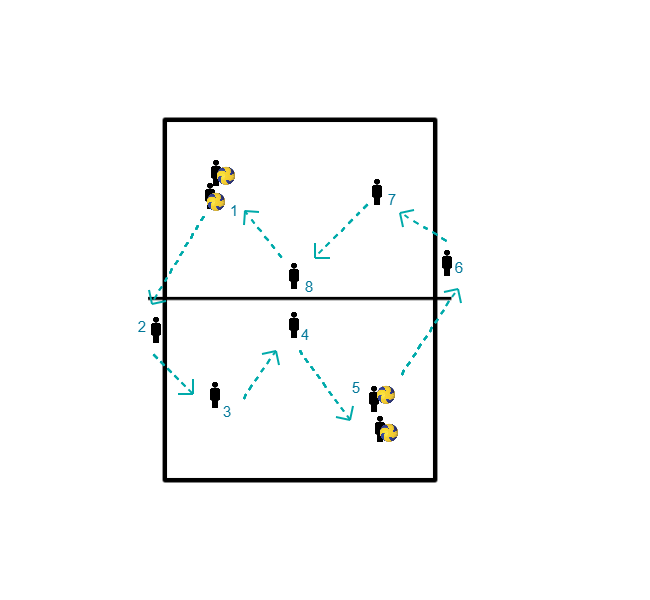
- Place a mat at random in each field.
- On 2 sides stand a group to serve.
- Serve on the mat.
- Then run after your ball, tap the wall, and join the line on the other side.
- Who hit the mat the most?
- Players must serve from behind the back line
- everyone in a line with the ball between their feet
- always jump with the ball between their legs
- they jump to a cone, around it and back again.
- tap the next one, etc.
- additions: forwards, sideways, slalom, through the hoop
- make it a competition
- first explain the technique (triangle, above the head, 10 fingers play the ball)
- Two pairs with a net in between and only play overhead.
- Let the pairs rotate (always new pairs).
This exercise assumes that the players know where they must stand and which zone is for them. So explain this well in advance
- Players stand in the right zone
- Reserve player serves the ball
- Block/defence, trainer throws in the ball
- After every service turn.
- Serve only when they think they are in the right position
- Also serve if they are not in the right position and serve on the uncovered position.
- They have to correct each other where they should stand.
- Throw a ball into the difficult zone every now and then. Who was this ball for?
- It's about recognizing your own zone. Who takes which ball? Call loose when in doubt etc
- Make clear agreements in advance!
- 2 teams,
- 1 with ball at the net,
- 1 without ball on back line flat on belly.
- Attacker hits ball, defender defends on 7meter line,
- Then short ball on 3meter line.
- Line up in the middle of the field.
- 1 person walks to the net (midposition) and blocks,
- sideways to set/outside and block there.
- 1 person remains standing on each side, creating a two-man block.
An exercise for the attacker. The attacker has to be available for a second attack after a block.
First the middle attackers. At the net stand the playmaker (S) and a head blocker (1) ready to start blocking. Next to them stands the trainer (T) with a ball. Three defenders (4, 5 and 6) are standing at the back of the court.
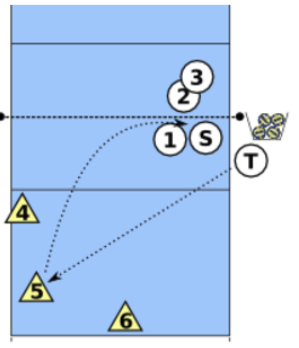
- The trainer hits the ball, and 1 and S block together.
- During the block the trainer smashes the ball to 4, 5 or 6.
- As soon as 1 is on the ground again after the block, 1 moves backwards for the attack run.
- 4, 5 or 6 defend the ball.
- S gives a setup to 1.
- 1 smashes the ball
- 1 retrieves the ball.
- 2 takes the place of 1 (1,2 and 3 rotate).
Swap with the outside attackers on the outside position.
- 1 playmaker
- 1 "false-dead" in the other half
- 1 attacker without ball
- Rest with the ball in a row behind the attacker.
- Number 1 with the ball throws to the distributor, who gives a set up and the attacker tries to score.
- The shamode tries to pass the ball and catch it, if he succeeds, the attacker is "dead" and has to take over the place of the shamode who may now join the row
- If the attacker scores he gets the ball himself and joins the back of the row
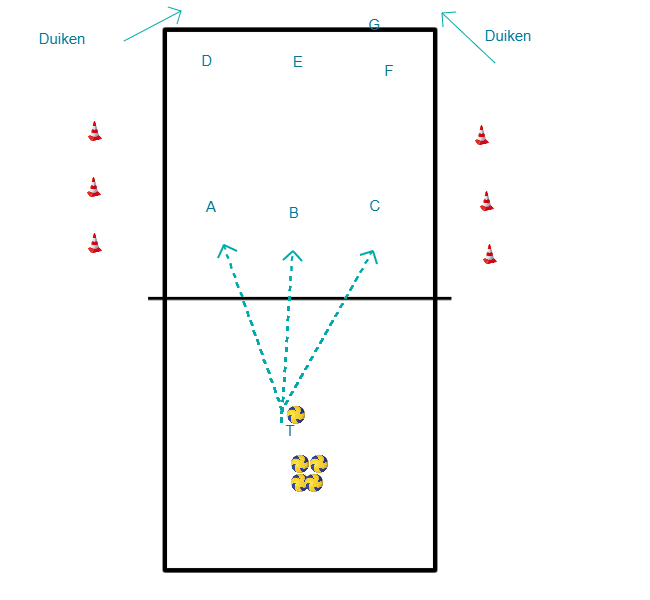
- T throws the ball to A, B or C who attack in front.
- The one who attacks runs behind the ball, the others slalom around the cones and then dive towards the back line
- Meanwhile D, E and F are ready
ball track = letters of the alphabet
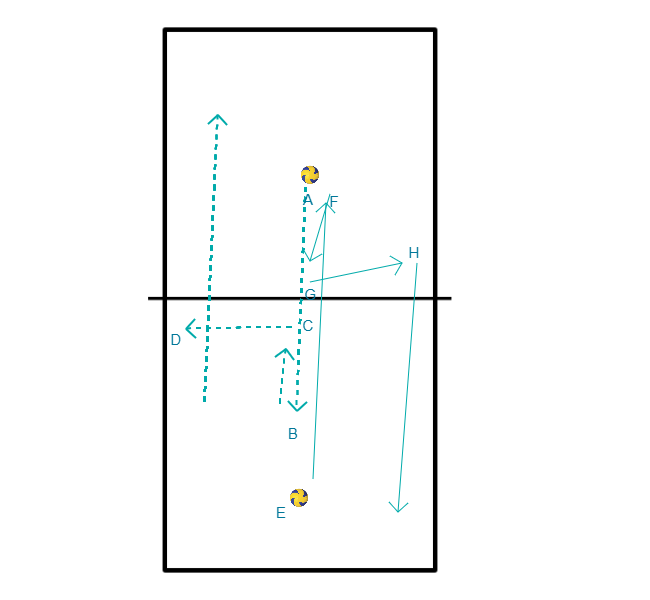
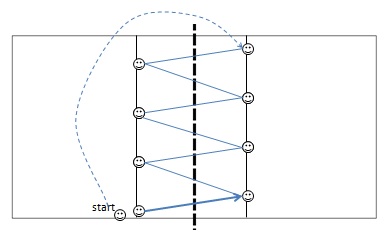
- Spread over 3m line.
- Pass the ball in a zigzag and follow through. See picture
- Later play underhand, only overhand.
- One side of the net underhand, other side overhand.
- One side of the net underhand, other side overhand.







